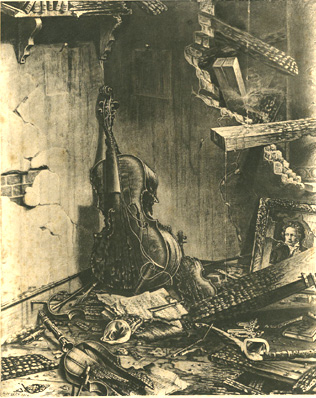|
The artist Ulrich Augustus (U.A.)
Hoegger was born in Switzerland in July, 1844.1
After studying art in Zurich he emigrated to the United
States in 1878 and settled in Philadelphia where at
first he made his living as a sign painter. He and his
first wife, Maggie, had one daughter, Katharine, born
ca. 1875.2 In 1881, he remarried, and he and
his wife, Emma P., had two daughters: Emma P. born June,
1881, and Freda A. born May, 1889.3 Hoegger also had a son who lived in
Munich and won some distinction of his own in the arts
and letters. Circa 1883, Hoegger established his own
salon and studio in the Kensington section of
Philadelphia:
His most famous creation was a painting that he would name "Verstummt" ("Silenced"): Hoegger began painting "Verstummt" in 1889 and finished it after eight years of work and study. Originally it represented a room in a conservatory that had been partially destroyed by fire. To have a correct working model the artist constructed a frame room designed and furnished after the fashion of a musical salon. This was set on fire and partially burned, the ruins serving as a model for the picture. The picture showed eight charred musical instruments, fragments of music, and damaged furniture. Two features were a large 'cello and a picture of Beethoven. In 1904 a fire occurred in Mr. Hoegger's studio, then at 2514 North 39th street, in which that half of the picture showing the door and furniture of the music room was partly destroyed. This the artist had cut out and allowed the significant features only to remain.5  In 1905, following the fire
that partially destroyed his most famous but ill-fated
creation, Hoegger had a black and white engraving
produced of the remaining portion of the work. This
print was published by Max Zeitler of Philadelphia,
engraver of the Great Seal of the United States. (Click for larger view)
Three years later the painting proved to be eerily
prophetic:
Ulrich Augustus Hoegger was himself "silenced" as a result of the burns he received in the fire that destroyed his studio and most famous painting. 7 See also: AskART.com, liveauctioneers.com, and Arcadja.com for other examples. |